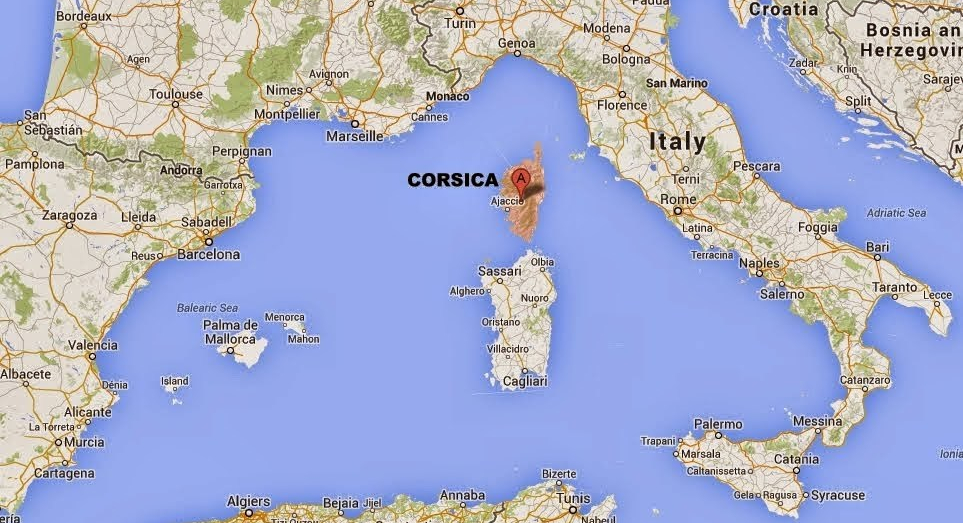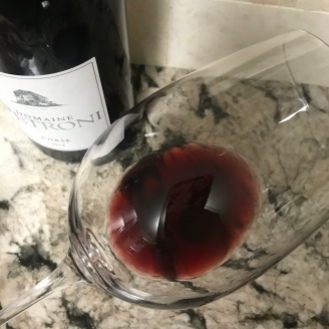Never thought of Corsica and wine before? Well, to be honest, neither had I, but the French #Winophiles are exploring the island and its wine this month and I have to tell you, I’m so glad I decided to join them. The wines I tried were not only delicious, they were very affordable, making Corsica a region I will definitely revisit on my wine drinking journeys!

The island of Corsica is a gorgeous Mediterranean island that geographically sits closer to the Tuscan coast of Italy and the island of Sardinia than it does to it’s mainland nation of France. Having been ruled by the Republics of Pisa and then Genoa, the influence of Italian culture remains to this day in both it’s wine and food. Of course, nearly 250 years of French rule has made an impact, resulting in a uniquely Corsican culture.
Settled in the 11th century by Phoenicians, viticulture has been a driving force on the island from the beginning. It became a French territory in 1769 – the same year that Napolean Bonaparte would be born on the island, in the town of Ajaccio. Born into a wine making family, as Emperor of France, he would bring attention to Corsican wines that, under Italian rule, had not made it much farther than Genoa and Rome. It’s interesting to think that if he had been born a year earlier, his fate may have been tied to Italy rather than France?
So what does Corsican viticulture look like? Let’s take a look.

The island is basically a big mountain range that encompasses the entire island. Covered in vineyards and surrounded by beaches, it is easy to understand why the entire island falls under the VDP designation Vin de Pays de l’Île de Beauté. Although about two-thirds of the wine produced falls under the l’Île de Beauté designtion, the island is home to nine AOC regions: Vins de Corse (covers the entire island); Coteaux du Cap Corse, Calvi (famous for Gris de Calvi rosé), Sartène, Figari, Porto Vecchio; Ajaccio, Patrimonio (Corsica’s first AOC), and Muscat du Cap Corse. The entire island also falls into one additional wine VDP designation – Vin de Pays de Mediteranée, which includes Rhône, Provence, and Corsica. C’est interessant no?
Grapes are grown in nearly every type of soil on Corsica — schist, clay, chalk, granite, and sand. Despite it’s geographic location closer to Italy, it includes some very French influences. Certain areas of the island are subject to the Mistral wind that wreaks havoc on southern France, and the island has a dense shrub growth known as “Maquis” that produces an herbal scent throughout the entire island. Similar to “Garigue” found in the south of France, some say they can detect the scent in many of the wines produced.
Home to more than 30 grape varieties, there are three that take center stage:
- Niellucciu: (pronounced neel-oo-choo) Once believed to be an indigenous grape of Corsica, it is now believed to be either the exact same, or a clone of, Sangiovese.
- Sciaccarellu: (pronounced shack-a-reel-oo) Also having Italian roots, it is now grown almost exclusively on Corsica
- Vermentinu ou Malvoisie: More commonly known as Vermentino, this grape is also an Italian grape that neighboring island of Sardinia is best known for (Sardinia is thought to be responsible for nearly half of all Vermentino wine produced).
Known for light but rustic reds, fairly complex roses, and excellent whites, the wines have characteristics that make them uniquely Corsican. Let’s take a look at what I opened.
Location Wines, Corse
100% Vermentino, $17.99
Produced under the Locations label by Dave Phinney of Orin Swift, I couldn’t resist this wine. Not having any frame of reference for Corsica, but having a love of most Dave Phinney wines, this was an easy pick for me and I wasn’t disappointed. The label is different from the other Locations wines in that it is not a single letter representing the country of origin, but rather a shepherd’s knife that is apparently a common sight on the island. It’s also interesting, and apropos of nothing, that the wine is bottled in Spain.
Stainless steel fermentation results in a wine with fresh acidity and flavors of green apple, almond and slight herbaceous note – possibly maquis? There was a slight lanolin note – which to me is more a feel than a flavor. This wine was truly unique and I would definitely buy it again.
I paired this wine with fresh bruschetta with a sprinkle of feta, goat’s cheese with herbs de Provence, olive tapenade, hummus, smoked tomato jam and roasted pork and vegetables. It went well with everything.
Domaine Petroni 2015, Corse
50% Neilluccia, 35% Syrah, 15% Granache
Domaine Petroni dates back to 1885 and sits on the east side of the island between Lake Diana and the Mediterranean Sea. It is a great representation of both Italian and French influence with the blend of grapes used. The wine is similar to a Sangiovese in weight and acidity, but the truly unique standout for me was a pepper note on both the nose and the palate – it made me think of Blaufrankisch. It also had bold red fruit flavors and aromas, with a silky smooth finish. This wine saw no oak in it’s journey to bottle, having been fermented in cement vats and aged in stainless steel.
It was amazing with both roasted pork tenderloin and vegetables, and with grilled cheese sandwiches – not your average grilled cheese sandwich – I have to give you a little more detail. Three different versions, all were amazing: 1. Shredded pork tenderloin (leftover), mozzeralla and cheddar cheese with Blackberry Farm smoked onion jam; 2. Ricotta cheese, mozzerella, cheddar and smoked tomato jelly; 3. Shredded pork tenderloin; cheddar, mozzerella, bbq sauce and bit of Wickles relish. They were a leftovers win to be sure! I also couldn’t stop thinking about this wine with pizza.
So what is Corsica known for in food? Well, it turns out, a little bit of everything, which might explain why both wines seem to pair well with everything I tried. Fresh seafood, stews, soups and pasta all are part of the Corsican cuisine. Some uniquely Corsican things are cheeses and livestock – both falling under AOCs of their own. Apparently there is veal and then there is Corsican veal. Also chestnuts! Chestnuts are ground into flour and used as grain on Corsica in much the same way we use other flours.
Have you ever had a Corsican wine? I’d love to hear about it!
And don’t just take my word for it please check out more Corsican wine and food pairings from the rest of the French Winophiles:
- Camilla of Culinary Adventures with Camilla shares “Friday Night Pizzas + Domaine Poli Niellucciu Rosé 2018”
- Robin of Crushed Grape Chronicles shares “Corsica – An Island and it’s wines #Winophiles”
- Martin from Enofylz Wine Blog shares “Mixiote de Pescado Paired with Domaine Petroni Corse Rosé”
- Linda at My Full Wine Glass shares “Spaghetti and meatballs for a Corsican wine (#Winophiles)”
- Gwen from Wine Predator shares something delicious…
- Payal at Keep the Peas shares “Corsica: The Maquis, The Mountains, The Sea (#winophiles)”
- Wendy from A Day in the Life on the Farm shares “Corsica; French with a lot of Italian Influence”
- Cindy from Grape Experiences shares “Drench Yourself in the Sunshine of Corsica with Domaine Petroni Rosé Corse 2018 and Provençal Vegetable Gratin”
- Nicole at Nibbling Gypsy shares “Corsican Happiness: Domaine Giacometti Sempre Cuntentu Sciaccarellu with a Flavorful Seafood Stew”










What a great little lesson in geography ,culture ,culinary preferences and of course wine knowledge.Your blog is just super I’m so proud of you
LikeLike
Thanks Dad! 😘
LikeLike
I want to try one of the reds from Corsica. I was very happy with the Rose I tasted.
LikeLike
And I am on the hunt for a Rosé! Cheers’
LikeLike
If this wine is as delish as the Domaine’s rose, I’m in! And that grilled cheese sammy:) What a great pairing-thank you!!!
LikeLike
I really want to try the Rose now! I bet it would also be amazing with the grilled cheese! Cheers!
LikeLike
So much to love here. The fact that you found “maquis” notes in the wine…and lanoline feel…I really want to try this wine. The description of the red like “Blaufrankicsh” seems spot on to me. The red I tasted was from further inland, but that is an apt description still! I want to search out one of those Corsican Rosés now!
LikeLike
I am so glad other people got the pepper note too – I wasn’t expecting it and wasn’t sure if I was just crazy! I am also on the hunt for a Rose! Cheers!
LikeLike
Great recap and the wines sound great! Also everything you had them with sounded delicious, from the herbed goat cheese and bruschetta spread, to the various grilled cheeses. Yum!
LikeLiked by 1 person
Thanks Nicole! So glad I joined in this month – now another place I want to visit!
LikeLike
I’m loving your pairings Cathie! I had the Locations Corse before I knew much about Corsica. As I recall, I really enjoyed it. I’m looking forward to trying the Petroni Rouge.
LikeLiked by 1 person
Thanks Martin! Too bad we all don’t live closer because I think all of us who the rouge want to try the Rosé and visa versa 😂
LikeLiked by 1 person
Love your pairings, and D. Petroni wines are delicious!
LikeLike
Love the pairings, and D. Petroni wines are delicious!
LikeLike
I keep wondering why I didn’t go inside … I liked too how they copied the door’s architecture in the little news box on the left and the sign.Premium wine
LikeLike